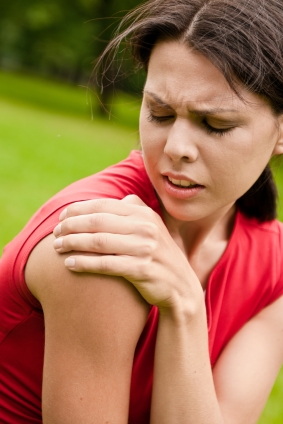 Shoulder injuries can be a real pain in the “you-know-what”…
Shoulder injuries can be a real pain in the “you-know-what”…
Can’t lift your arm, brush your hair, or play your favorite sport. Can’t even get a good night of sleep…
So what exactly is a Rotator Cuff Injury?
A rotator cuff injury is a common injury in both athletes and those who work in manual labor where heavy lifting and reaching overhead are necessary.
The injury itself, in the beginning, can appear innocuous, because there is normally one of two things that happen.
An acute injury manifests itself from a sudden trauma such as falling on to the shoulder during a routine activity or accident. Whereas a chronic injury happens over time, developing slowly after months or even years of similar, repetitive actions such as lifting or throwing.
The shoulder, like the rest of the body, is a remarkably complex system of muscles, tendons and bone that all work in perfect harmony and actually has the greatest range of motion in the entire body.
There are four major muscles in the rotator cuff that do several different tasks, but the primary tasks are to stabilize the shoulder and rotate the arm within the shoulder joint. The muscles also hold the arm firmly inside the shoulder socket.
A rotator cuff injury can manifest itself in several ways: damage to the muscle or tendon, continuous repetition or general aging and arthritis. The damage can be a strain, tear or inflammation, depending on the type and severity of the injury itself.
The damage to the shoulder then presents any number of issues ranging from mild to severe pain, to limited range of movement.
If you’ve hurt your rotator cuff or you’re trying to recover after a shoulder surgery, click on the link below to watch my free video presentation, which will show you “step-by-step” how to fix your rotator cuff injury once and for all…



Rest ,ice-covered ,immabilization are essential to rorate cuff injury.
What do you recommend for rotator cuff issues — I have limited range of motion and PT aggravated the
area?
Tong, Sure Rest and Ice are important in the acute phase of the injury but after the acute phase is over, you have to get that area moving or it will get tricky…
Steve
Donna,
1. Please understand that the muscle that make up the rotator cuff are very small and do a specific job, and thus when they are out of balance they are very fickle, and yes irritation is going to be part of the process, not to mention that it will take time to get over the hump, the recovery from a rotator cuff will test you but there are action steps that you can take…
2. Job one is to control the inflammation, breakup scar tissue and improve circulation ASAP
Heal n Soothe can help, if acute
Topical pain creams like Rub on Relief can help, if acute
Heating pads can help, if sub acute
Massage can help, if sub acute
3. Job two is to find a therapist or a specific program for rotator cuff injuries as there are super specific stretches and exercises that you will need to do in order to restore full range of motion and balance with strength and stability and if you are not doing the correct stretches and exercises it’s a huge waist of time.
4. In the mean time, I suggest that you try some of the modalities and do simple activities that are just movements (within your pain tolerance) that open up and keep the area active, I can not tell you to do the exercises that your therapist told you to do because I dont know what they suggested, so please act on jobs 2 and 3 as soon as you can because the longer the RC stays imbalanced the harder it is to correct…
Steve